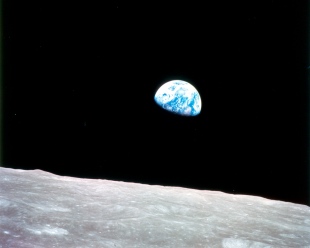
Woody Allen once observed that “ninety percent of life is just showing up.” But in 1948, Bing Crosby convinced the ABC radio network that “showing up” wasn’t actually necessary. That was the year he launched the first pre-recorded weekly radio broadcast. The previous year he’d made the same request of NBC, but they’d refused. For NBC, by definition radio programming was live with the exception of a few commercials.

Radio and TV historian Steve Schoenherr decribes Crosby’s deal:
The new ABC network, formed out of the sale of the old NBC Blue network in 1943 to Edward Noble, the “Lifesaver King,” was willing to break the tradition. It would pay Crosby $30,000 per week to produce a recorded show every Wednesday sponsored by Philco. He would also get $40,000 from 400 independent stations for the rights to broadcast the 60-minute show that was sent to them every Monday on three 16-inch aluminum discs that played 10 minutes per side at 33-1/3 rpm.
Eventually Crosby buys the first two Ampex 200A tape recorders, serial #1 and #2, to record his show. This allows him to control microphone placement and do multiple takes to get the best performance possible. As a film actor, Crosby had been used to this kind of production process. After hearing the tape of Crosby’s demo, ABC ordered 12 of the Ampex recorders and that was the beginning of the end of the broadcast of live radio programming.
By not showing up and instead creating the first pre-recorded radio broadcast, Bing Crosby set the pattern for all modern “broadcast” media. (He also pioneered microphone technique for vocalists.) Perhaps it never occurred to anyone that the audience would one day assert the same privilege that Crosby did in 1948. We are all Bing Crosby now, and there’s very little that we need to actually show up for in the world of broadcast media.
Now there’s only sports and news programming enveloping the earth in a new real-time synchronization of time that knows neither day nor night. As Richard Nixon sings in John Adams’s opera Nixon in China: “News has a kind of mystery.”
The heads of programming at the Networks used to decide when a particular recording would be played over their syndicate of local stations. Now that power rests with the audience. What’s “new” is what’s new to you; and the quality of material in the vast library of pre-recorded media far outstrips whatever is being presented live in real time right now. Like Crosby, we the audience, don’t bother showing up for the broadcast. We’ll choose the time and place for the performance to occur.
Time present is the sequencing of the recordings of time past. Time future is what is yet to be recorded, an appointment for our DVRs. If all time is pre-recorded, all time is unredeemable. Nothing need be missed, there is no possibility of that. Everything is just a matter of priority in the great queue of items awaiting our future consumption.
When we mortals are presented with seemingly infinite banquets aimed at our appetites, the discussion quickly turns to the seven deadly sins; and in particular, gluttony. While we can now consume anything at anytime and practically any place— what is it that we should be consuming? What asserts control over our potentially infinite appetites? Is it the rational “I” who decides while basking in the luxury of its individual freedom? Does our access to the infinite buffet transform us into a mature adult who can keep, not only its ego, but its id in check? Or do we end up joining the rest of the gluttons in Dante’s third circle of the inferno?
And as we more fully become Bing Crosby, do we engage over our real-time social networks by playing pre-recorded snippets for the purpose of constructing an ideal projection of ourselves as the narrator of our lives? Walter Benjamin regrets our loss of the “aura” in a work of art in the age of mechanical reproduction. Are these new networks we’ve constructed even capable of transmitting “aura” across their tangle of wires? And if they are, are we capable of telling the difference? Through the recording arts, Crosby was able to create a technically better performance. He accomplished this through deferring the moment of transmission. The message is worked and re-worked at a distance from the performance date. The medium itself has deferral and distance built into it. As an audience we now re-wire broadcasting to take advantage of these qualities.

What Crosby removes from the encounter is the element of chance, the possibility that something unexpected could happen. Crosby pre-rolls the dice and presents the best outcomes for your enjoyment. There’s a presupposition in this approach that enjoyment is increased when all error is absent and the moments of spontaneity are pre-auditioned and arrives with the appropriate imprimatur. What we miss is the moment when the wrong note suddenly becomes right. Herbie Hancock describes such a moment while playing with Miles Davis:
“And just as Miles was about to start his solo for ‘So What,’ at the peak of the concert, I hit a note that was so wrong I thought I had crumbled the show down like a falling tent,” he recalled.
“And Miles took a breath, and played some notes that made my note right. It took me years to understand that Miles didn’t judge what I played. He worked with it. That lesson wasn’t just about music. It was about life.”
Bing changed our relationship with time. And while it may seem like we’ll manage to avoid error and present a photoshopped version of ourselves to the world, we simply encode our errors at another level. The unexpected unexpected emerges despite the best laid plans.
Even a pre-recorded roll of the dice will never abolish chance…
Comments closed








